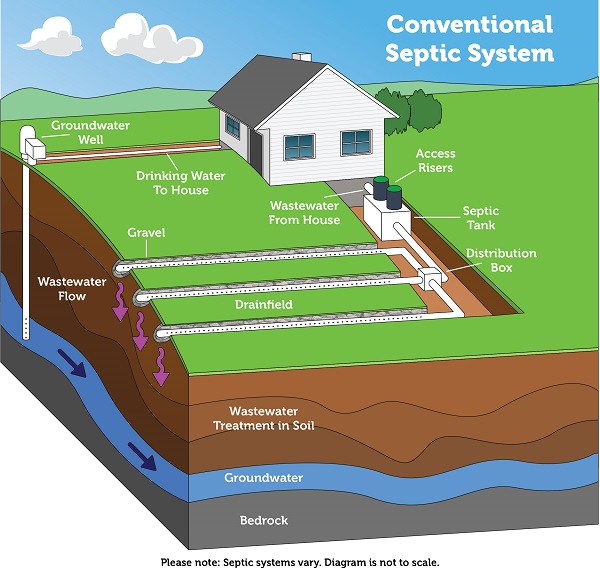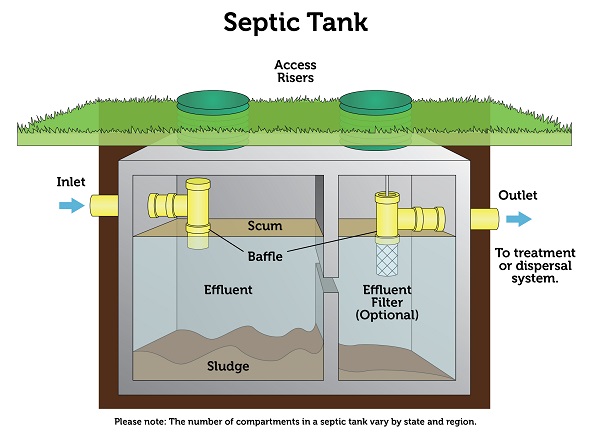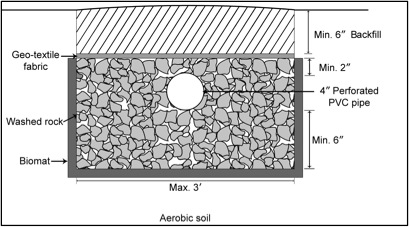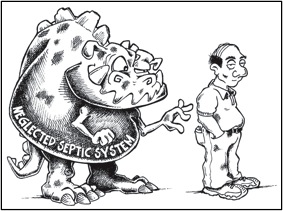- Is Your Home or Building on a Septic System?
- Locating the Septic Tank and Drainfield
- How a Septic System Works
- Maintaining a Septic System
- Signs a Septic System is Failing
Many buildings and homes have on-site (also written as “onsite”) wastewater management systems, commonly called septic systems. Other terms that are used are: decentralized wastewater treatment systems, onsite wastewater treatment systems, cluster systems, package plants, on-lot systems, individual sewage disposal systems, or private sewage systems.
Because septic systems are buried, it is easy to forget about them as they quietly, elegantly, and efficiently maintain human and environmental health. Septic systems are the norm in rural areas, but they can be quite common in urban and suburban areas as well. It is important to know if your building (i.e., home or business) is on a septic system.
Is Your Building on a Septic System?
The answer to this question may not be obvious. A building that appears to be on a municipal sewer (hereafter, “sewer”) system may actually be on a septic system. It is not uncommon for renters to have little information about the fate of their home's wastewater. Some of the following clues or indicators will help determine if the building has a septic system or is served by a sewer system:
- The city or municipality will charge for sewer service. Take a close look at the water bill and determine if there is a fee labeled “sewer” or “sewer charge.” If there is a charge for this service, the building is most likely on a sewer system.
- Look up and down the street and search for sewage access ports or manholes. If a sewer system passes in front of the property, the home is likely to be attached to it. Ask the neighbors if they are on a sewer or septic system. If the houses on either side of your home are on a sewer system, then it is likely that your home is as well.
- However, keep in mind that even if a sewer line runs in front of the building and the neighboring homes are on a sewer system, your home or building may not be. If the building is older than the sewer system, it may still be on the original septic system.
- Check with your local health department. This agency does final inspections to ensure that septic systems conform to rules and regulations. They may have a record and/or a map of the system and will provide this information on request.
All property owners need to know if their property has an on-site wastewater treatment system. In Georgia, the property owner is responsible for the smooth operation of the septic system and any maintenance and repairs.
Locating the Septic Tank and Drainfield
Finding a septic system can be challenging. They can be buried in the front, back or side yard. After a few years the soil may appear just like the surrounding soil, making the system difficult to locate. In dry weather, the grass may be drier in the shallow soil over the tank and greener over the drainfield where the cleaned water is released, but this is not always the case.
You may also see some slight depressions in straight lines that could indicate the drainfield. If you have a copy of your septic system from the local health department and the drawing is close to the depressions, then that could be another indication of the drainfield.
Even if you do not know where your system is located, somebody else might. The contractor who built the house should have provided the first owner with a map of the tank and drainfield locations. Check the paperwork that came with your house; it might be in there.
Your local health department would have inspected the installation of the system and any modifications to it. They may have a sketch of the system location and will provide it on request. Unfortunately, if the system is very old, any records associated with it may be incomplete or nonexistent. If your house is older, do not be surprised if the record the health department has is drawn on something other than graph paper. The information the health department has should also contain information on type of system, length, and depth.
Look closely at the building. If the building is on a crawlspace or has an unfinished basement, look for where the wastewater pipes come together and leave the basement or crawlspace wall. This pipe is called the building sewer. Often, the tank is located 10 to 20 ft outside of the home, directly in front of the building sewer. You may even be able to find a clean-out plug to help locate sewer system outside the house.
Use rebar or a similar metal probe to “feel” for the tank. Before attempting this, call 811 and have the location of your utilities marked. This free service can prevent you from driving a rod through your gas, water, telecommunications, or electricity line. As a reminder, the 811 group will only locate utility lines and not those “owned” by the home/business. These could be irrigation lines, electric runs for outside lighting, and similar lines. The tank may be several feet deep, so a hammer or mallet may be needed to tap the probe into the soil. Try to feel for the tank after a rain when the metal probe will move through wet soil easier.
Begin driving the probe into the ground about 6 ft from the house directly in front of the building sewer. This should be done gently; be very careful not to puncture the building sewer. Once an obstacle is encountered, gently probe again about a foot further out and continue until the probe goes deeper, indicating you have reached the end of the tank. A tank is typically 5 by 8 ft, but sizes can vary. Find both ends of the tank using this method and mark them. Keep in mind that there may be rocks, pipes and other debris that “feel” like the tank, but are not. The top of the tank is usually found 1 to 4 ft beneath the surface of the ground. Generally, the lid or access port is on the same level as the top of the tank, but it can be located on a riser as well. Your local health department has a list of certified professionals who can also help you locate your system.
Once the tank is located, draw a rough sketch of its location relative to the house so it is not lost again! Now that the tank is located, it may be easier to find the drainage lines by looking for greener grass, particularly after dry weather as mentioned above.
How a Septic System Works
 Figure 1. A typical septic system. From "Types of Septic Systems" by the U.S. Environmental Protection Agency, 2024 (https://www.epa.gov/septic/types-septic-systems#conventional).
Figure 1. A typical septic system. From "Types of Septic Systems" by the U.S. Environmental Protection Agency, 2024 (https://www.epa.gov/septic/types-septic-systems#conventional).The septic system consists of three components (Figure 1): the tank, the drain lines or discharge lines, and the soil treatment area (sometimes called a drainfield or leach field).
Tank sizes vary depending on the size of the building. The average home (three bedrooms, two bathrooms) will often have a 1,000-gallon tank. New tanks must have two chambers, while older tanks may have only one. The tank is often made from concrete, but other materials are also used.
The tank works by settling and microbial digestion of waste. As wastewater flows into the septic tank, three layers are formed (Figure 2): a bottom sludge layer, the top scum layer and a “clear” zone in the middle. Heavy solids settle to the bottom, forming the sludge layer, and grease and light solids float to the top to form the scum layer.
 Figure 2. A typical septic tank. From "Types of Septic Systems" by the U.S. Environmental Protection Agency, 2024 (https://www.epa.gov/septic/types-septic-systems#conventional).
Figure 2. A typical septic tank. From "Types of Septic Systems" by the U.S. Environmental Protection Agency, 2024 (https://www.epa.gov/septic/types-septic-systems#conventional).Bacteria and other microbes are responsible for partial decomposition of the sludge. Fortunately, many of the microbes involved are present in large numbers in the human intestine. A new supply of these is added to the septic tank with each flush (no additives are needed). However, the microbes cannot break down all the material in the sludge, which is why septic tanks need to be pumped out every 3 to 7 years.
A tee on the discharge side of the septic tank only allows water from the middle layer to go out to the field lines. As new water comes into the septic tank, an equal water volume is pushed out of the discharge lines and into the drainfield. There may be a distribution box located between the tank and drain lines (Figure 1), sending wastewater to several lines in the drainfield. The water trickles out of the perforated drain lines, through a layer of gravel and into the soil (Figure 3) if your distribution system is a pipe and gravel system. If your distribution system is something other than pipe and gravel, the water still comes from the septic tank but enters the soil without trickling through gravel.
 Figure 3. A typical drainfield using pipe and gravel.
Figure 3. A typical drainfield using pipe and gravel.The soil is teeming with life. Plants, bacteria, fungi and protozoa, along with larger creatures such as mites, earthworms and insects, thrive in the soil. All these creatures help release nutrients and other compounds from the wastewater, using and reusing them in the soil and cleaning the water. Minerals and metals bind to soil particles, removing them from the wastewater. The treated water eventually moves into ground water.
Maintaining a Septic System
Poor maintenance is the most common cause of septic system failure. Failing septic systems are expensive to repair or replace, and the cost of repairs falls on the property owner (Figure 4). Fortunately, it is relatively easy to maintain your septic system and avoid expensive repairs.
 Figure 4. Poor maintenance is a common cause of septic system failure. It is in your best interest to know where the system is, how it works and how to maintain it.
Figure 4. Poor maintenance is a common cause of septic system failure. It is in your best interest to know where the system is, how it works and how to maintain it.Have the tank inspected and pumped periodically, ideally every 3 to 7 years. If you don't know the last time the tank was pumped, pump it. Previous property owners may have overlooked this essential step.
Do not drive or park over the tank or drainfield. This may damage or collapse the tank or drain lines or compact the soil, decreasing the efficiency of the drainfield.
Do not use sinks or toilets as trashcans. Dumping cooking oil, paper towels, hygiene products, household chemicals, paint, kitty litter, coffee grounds or cigarette butts into sinks or toilets will increase the sludge layer in the tank and, at best, it will have to be pumped more often.
Remember, garbage disposals increase the need for routine pumping. Eggshells, bones and vegetables do not digest well and add more sludge to the tank.
Consider the septic system in the landscape design. Tree and shrub roots can grow into the drain lines and even the tank. Also, it is not wise to eat vegetables grown over drainfield lines [see Dorn, S. (2022). Ornamental plantings on septic drainfields (Publication No. C 1030). University of Georgia Cooperative Extension.]
Use water wisely. Any water that goes down a drain or toilet ends up in your septic system. Repair leaking faucets and toilets to prevent water overload. Don't overtax the system by using a lot of water in a short time. Keep in mind that a saturated drainfield may not be able to absorb water from multiple loads of laundry on a rainy day.
Do not use additives. The Georgia Department of Public Health discourages the use of additives in septic systems, and scientific studies offer little support for their use. Additives are sold as treatments, cleaners, restorers, rejuvenators or enhancers. Biological additives, sold as starter agents or aids for routine maintenance, are made from bacteria, yeast or enzymes. Chemical additives are sold to break up oil and grease or unplug drains. Additives do not jump start a new or recently pumped system. They do not eliminate or reduce the need to pump out the septic tank. In fact, chemical solvents can break solids into smaller particles that do not settle to the bottom of tank. These small particles remain suspended in the water and move into the drainfield, potentially clogging the lines. Acids can corrode concrete tanks and distribution boxes.
Signs a Septic System is Failing
These are signs of a failing system:
- Sinks and toilets drain slowly
- Backed-up plumbing
- Gurgling sounds coming from the plumbing
- Sewage odors in the house or yard
- Wet or mushy soil in the yard
- Standing water that is greyish in color
- Grass growing faster and greener in one particular area of the yard
- Bacteria in well water
If any of these signs are noted, contact your local health department. A health department environmentalist can help identify potential problems. The local health department also has lists of state-certified contractors who can make repairs. Repairs or modifications to the system must be permitted and inspected by the health department. Be sure to be present when the health department inspector and contractor meet to discuss repairs to your system.
Problems with a septic system must be addressed. Failing systems release partially treated household waste into the environment. Untreated human waste is a health risk. It can contaminate nearby wells, ground water, streams and other sources of drinking water. It can also pollute rivers, lakes and shores. The nasty smell of a failed system can cause property values to decline. Failed systems can delay property sales and halt building permits. In a nutshell, failed systems can impact your family, your neighbors, your community and your environment. Yes, it can be very costly to repair or replace a failed septic system, but a properly working and well-maintained system is vital.
Septic systems are an efficient, elegant and inexpensive way to treat and dispose of wastewater. When properly maintained, they can protect and maintain both public and environmental health for years.
The original authors of this manuscript are Ellen M. Bauske (retired program coordinator, UGA Center for Urban Agriculture); Mussie Habteselassie (professor, Crop & Soil Sciences); and L. Mark Risse (professor and director, Marine Extension). It was revised by Gary Hawkins, Extension Water Resource Management Specialist.
Status and Revision History
Published on Aug 15, 2013
Published with Full Review on Mar 28, 2017
Published with Minor Revisions on Oct 18, 2024


























































